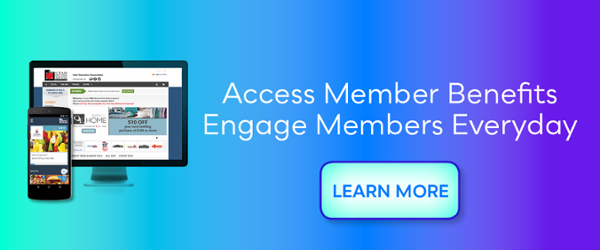Member Benefits and Democracy: Do Your Members Have a Voice?
The 2020 US election is complete. We hope everyone was able to vote safely and to make your voices heard. No matter how you feel about the results of any particular election, I think we can all agree that it’s wonderful to have a say in our future.
As we anxiously wait for the final votes to be tallied, here’s a question to keep your mind busy. Do your members have a say in what benefits they receive? Even with many value-added benefits to select from – like discount programs, birthday rewards, points earning, surprise and delight campaigns, etc. – you don’t have to blindly guess what members want. We’ve got some tips to help you figure out exactly what will keep them coming back year after year.
After all, you want your members to use and enjoy their membership perks, right? Otherwise what’s the point of offering them in the first place?
Empowering Member Voices Leads to Retention
If it all sounds too complicated, consider this: when members feel heard and appreciated, they form deeper connections with the businesses they frequent. Those feelings of loyalty often translate into repeat business, referrals and more.
- 63% of customers say that organizations should make getting to know them better a top priority (Loyalty360)
- When brands develop a history of transparency, about 90% of consumers said they are more willing to give brands a second chance after a bad experience, and 85% say they will stick with brands during a crisis when they are more transparent overall (Sprout Social)
- 62% of high-income consumers said that feeling like they had a personal relationship with a brand was a factor in loyalty (YouGov)
- Top five drivers of member satisfaction are: meets needs, enjoy participating, makes brand experience better, consistent with brand expectations, and rewards/benefits are appealing (Bond)
On the other hand, when members think you’re not listening, they’ll make their voice heard in the only way they can, by leaving you for another organization.
- 57% of consumers listed “having a negative review unaddressed while continuing to receive offers for similar products” as the top reason they would break up with a brand (Talend)
- 43% of consumers would think about taking their business to a competitor if they were not given the option to speak with a human (Calabrio)
- Nearly 50% of customers say they’ve left a brand to which they were loyal to go to a competitor that is better at meeting their needs (InMoment)
- A third of consumers are disappointed with a brand because of perceived lack of attention, 16% are frustrated and 12% are distrustful (Episerver)
How to Empower Your Members’ Voices
So... are you ready to incorporate member input into your benefits design?
Just like with the US’s founding fathers, it will probably take a little trial and error to home in on the exact amount of say your members should have in organizational decisions. Do you let members vote on the association member benefits they want? Do you elect a representative to speak on their behalf? Can they really be trusted to design appropriate benefits, like the best discount program, without blowing your budget?
The masses don’t always know what they want, or what’s best for them. So giving them too much say on too many decision will most likely yield chaotic benefits, irritated members, or both.
But if you can find that balance, where members feel heard and valued, then you’ve taken a huge step toward cementing a strong emotional connection with them. And emotional engagement is the very definition of member loyalty.
Here are four levels of member involvement organizations can work through to discover which fits with your unique membership.
Level 1 – Listening (and Responding)
 When members reach out, organization leaders should listen and respond. Anything less leaves you dangerously close to a dictatorship. If you’re not working to resolve member issues as they happen, the only recourse left will be for them to leave, which is the last thing you want.
When members reach out, organization leaders should listen and respond. Anything less leaves you dangerously close to a dictatorship. If you’re not working to resolve member issues as they happen, the only recourse left will be for them to leave, which is the last thing you want.
Even if you have efforts in place, you probably have some room for improvement. There’s a big difference between a customer service team delivering bare minimum efforts and one that is laser focused on creating an excellent customer experience.
As members turn to social media more and more to interact with their favorite organizations or air grievances, businesses in turn need to place extra focus on responding where appropriate. This is especially important when you consider that other members and potential members will see your responses (or lack thereof). Nearly half of consumers say their purchasing decisions are influenced by friends' social media posts about the businesses they interact with. And unaddressed grievances are huge red flags, signaling a company's lack of dedication to customer service. Luckily, 33% of negative reviews on Yelp turn positive when organizations take the time to respond.
While responding to feedback is important, members usually only reach out when they are extra satisfied or very dissatisfied, so you’ll ignore an entire group of valuable members if this is your only effort.
Level 2 – Anticipating Needs
You can solve even more problems by preventing them from happening in the first place. The easiest way to do this is by assigning a member advocate. This is one or more people on your team whose job it is to know your current members and/or map out the kind of people you want to attract to your organization in the future. It’s a little like electing a representative to speak on behalf of their needs.
Ideally, organizations should be collecting member data and recording things like renewal rates, participation in value-added benefits like exclusive discount programs, ad engagement, etc.
 On top of that, another helpful tool is social listening. This involves monitoring what people are saying about you online, even when they’re not talking directly to you. It also means watching your members’ social media activity: what they’re talking about, what hashtags they use frequently, what they’re interested in. This kind of data puts you in the know about current trends and sentiments that direct interactions simply can’t reveal.
On top of that, another helpful tool is social listening. This involves monitoring what people are saying about you online, even when they’re not talking directly to you. It also means watching your members’ social media activity: what they’re talking about, what hashtags they use frequently, what they’re interested in. This kind of data puts you in the know about current trends and sentiments that direct interactions simply can’t reveal.
Armed with this information, member advocates can design a path for member integration, smoothing out any pain points before they become a problem, and ensuring that the rewards are well worth the journey.
Level 3 – Asking Members Directly
If you really want to know what makes your members happy, your best source of information is the members themselves. Watching the data gets you part way there, showing you how members are interacting with their member benefits. But if you want to know how they feel about those benefits, you’ll have to ask.

At Access, we love surveying members on behalf of our clients. In doing so, we’ve been able to help clients figure out which benefits could be trimmed, leaving more room in the budget for the popular options. We’ve successfully pinpointed barriers that were keeping members from fully engaging, and asked together created solutions.
Members are a wealth of information. Here are a few tips for effectively extracting that valuable feedback in a positive way. Doing so will get you the answers you need AND leave your members feeling that you value what they say.
- Let your goal guide the questions you ask. For example, if you’re trying to solve a specific issue or just give yourself a feel for general member sentiment, you can elicit measurable metrics from questions that use a scale. In this case, asking members to rate their satisfaction with a certain benefit on a scale of 1-10 will give you a base line on which you can track improvement in subsequent surveys. On the other hand, open ended questions about what people expect to get out of their membership can give you insights you might not have anticipated had you only provided a selection of options to choose from.
- Advertise your survey well. It’s actually an extra benefit to have a good reason to talk to your members and prospective members. Ideally, you’ll post the link and request everywhere your members interact with you. Some locations might include your website, a dedicated email or series of emails, on social media, or on your app. If you want to survey prospective members, you may need to branch out even further, and you’ll want a way to keep those results separate for when it comes time to analyze results.
- Keep it short, simple and fun. You’ll get more participation on a less time consuming survey, meaning you’ll have a wider pool of responses. If you do want a more extensive survey, you may need to entice participation with a special reward for those who finish. But that's okay because 75% of members indicate they want to be rewarded for things like taking a survey. Another strategy might be to break it up into smaller chunks, perhaps even single follow up questions after members complete certain interactions.
- Thank members for their participation as soon as they submit their feedback. Then, follow through by sharing results with all participants soon after the close of the survey period. Finally, thank them one more time when you announce any changes you’ve made as a result of survey answers. This act of expressing your gratitude is a crucial step in making the experience positive and worthwhile for members.
Level 4 – Letting Members Choose their Benefits
If you want to take it a step further, consider asking members to vote on specific benefits, effectively letting them design their own loyalty program. This is closer to true democracy, and in small amounts, it can greatly enhance your relationship with current members and give new member a fresh reason to join.
 Admittedly, your membership is too fickle and ever-changing to design their benefits from the ground up. But if you’re debating between a birthday freebie or surprise deep discount, your members are more likely to appreciate (and use) a benefit they chose themselves.
Admittedly, your membership is too fickle and ever-changing to design their benefits from the ground up. But if you’re debating between a birthday freebie or surprise deep discount, your members are more likely to appreciate (and use) a benefit they chose themselves.
Recently, The Shoe Company unveiled their new loyalty program as having been designed for and by its members. The company surveyed 13,000+ members and potential members in order to pinpoint exactly what benefits appealed to them the most. The Shoe Company’s president Mary Turner reported she’s proud of their customized approach to rewards management which lets them “get personal’ and connect with our customers at a deeper level.”
 To make sure your efforts are as successful, here are a few tips:
To make sure your efforts are as successful, here are a few tips:
- Each person gets a vote, and only one vote, just like in any election. Advertise the vote well for maximum exposure so everyone has a chance to participate. Then, as you’re analyzing responses, don’t let any one person, no matter how vocal, determine the course of the entire exercise.
- Limit the options to only ones you'd be happy to support. While leaving some options open-ended could yield some interesting responses you may not have otherwise considered, it’s more likely to put you in an uncomfortable situation. There’s always the risk of getting put on the spot by members publicly demanding the world on a platter, or getting trolled by votes for the Boaty McBoatface of loyalty programs.
- Follow through with the popular choice, and quickly. Asking members to vote on their benefits is a promise that you will offer the winning option. Any excitement you generate by involving them in the decision-making process will quickly turn to disgust should you go back on that promise, or take too long to implement. Ideally, you’ll be prepared to launch their chosen benefit with a rush of celebratory marketing aimed at encouraging people to engage and use right away, while excitement is still high.
Help Your Members Feel Heard
Whatever level you choose, just make sure that your members know you care about their concerns and needs. When you listen and respond, ask for feedback, and/or involve members in the decision making process, you strengthen your emotional connection with them.
If you need even more distraction from your election results jitters, here are a few more fantastic articles to help you along your path to democratizing your member benefits.
Topics: Customer Engagement, Member Benefits, member engagement, loyalty programs, best employee discount programs, membership benefits

Written by: Kendra Lusty





.jpeg)







Share your Comment.